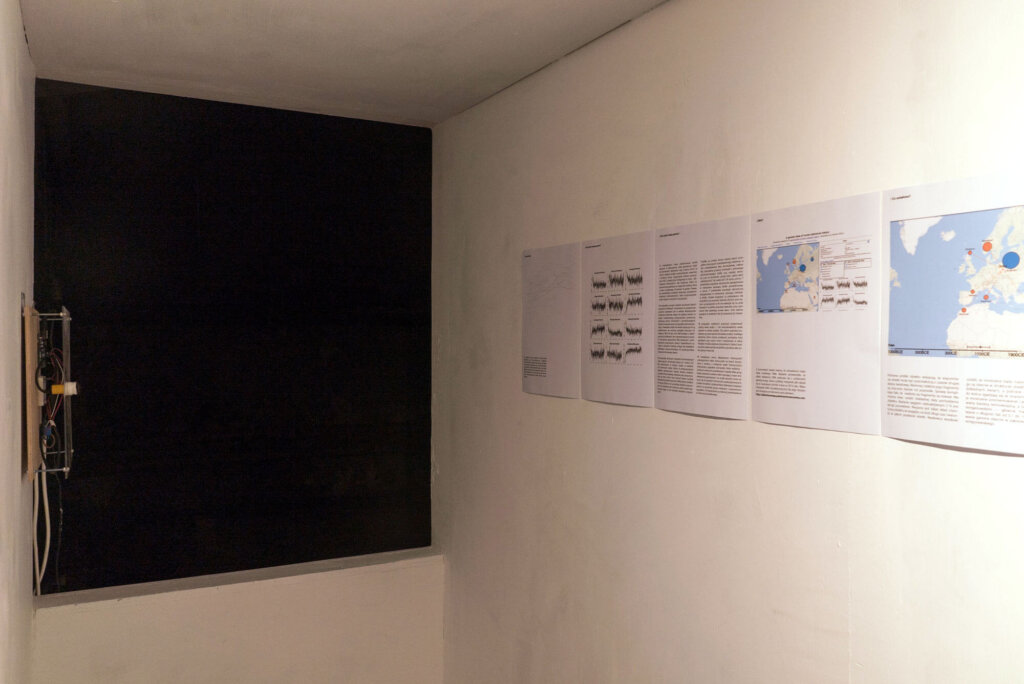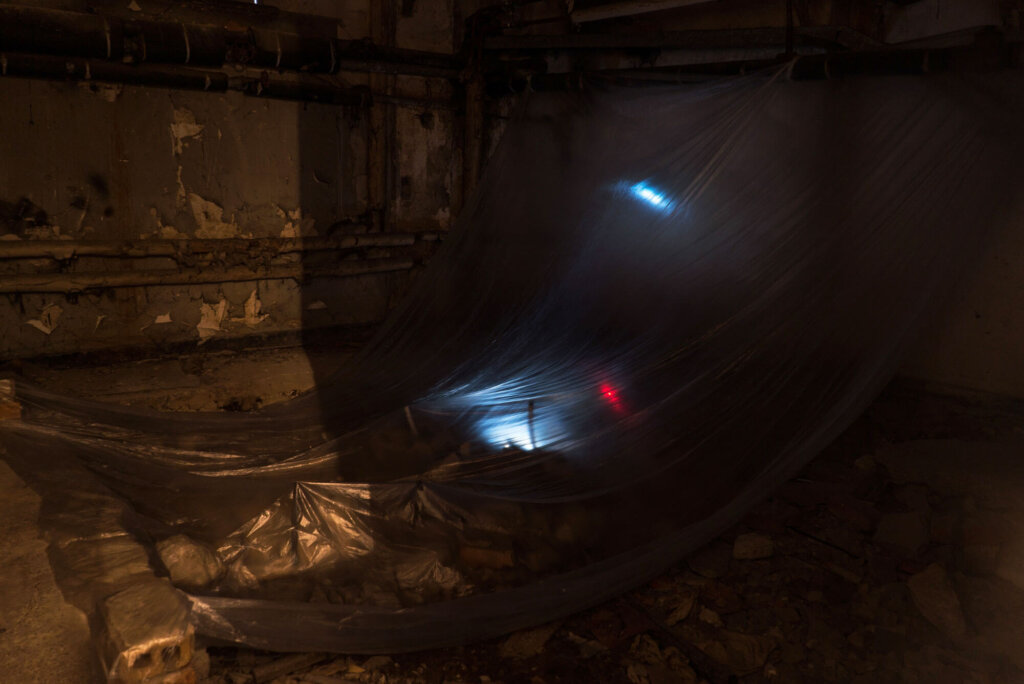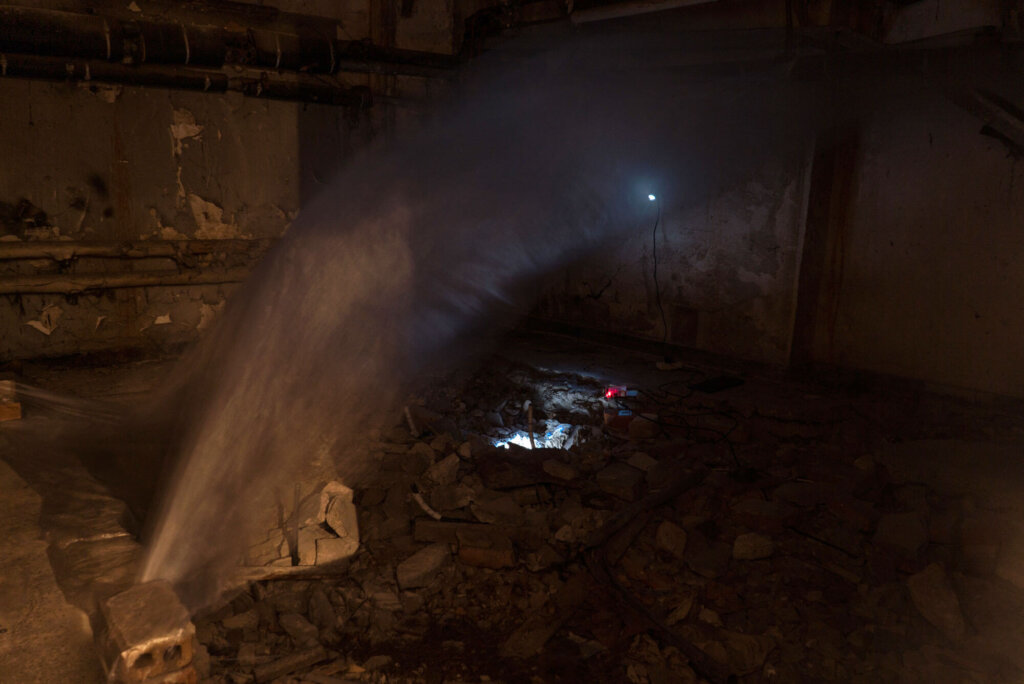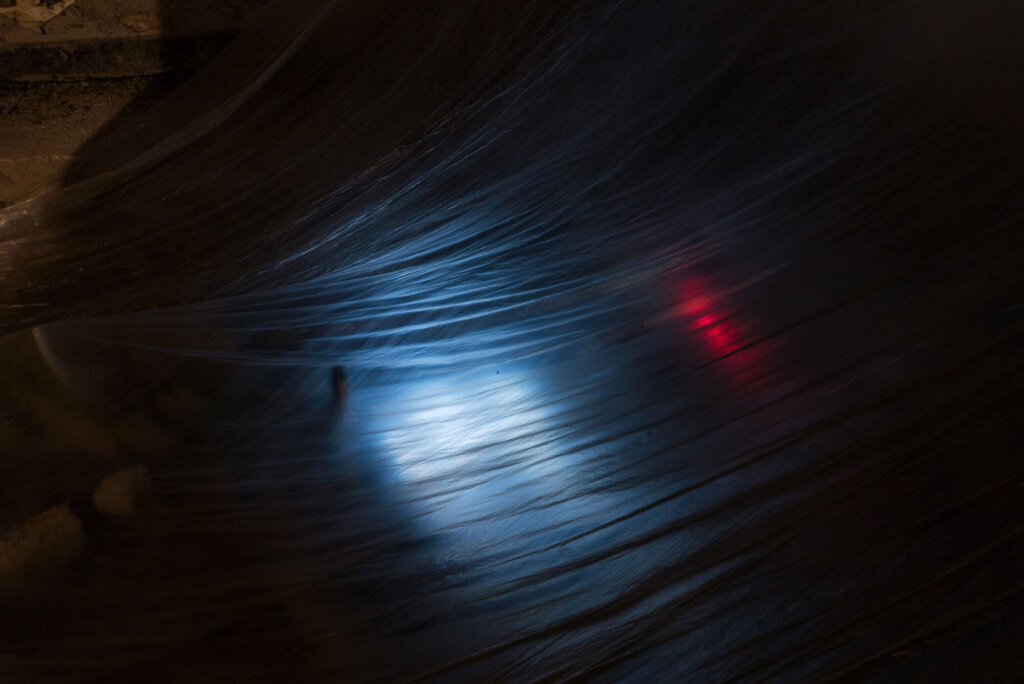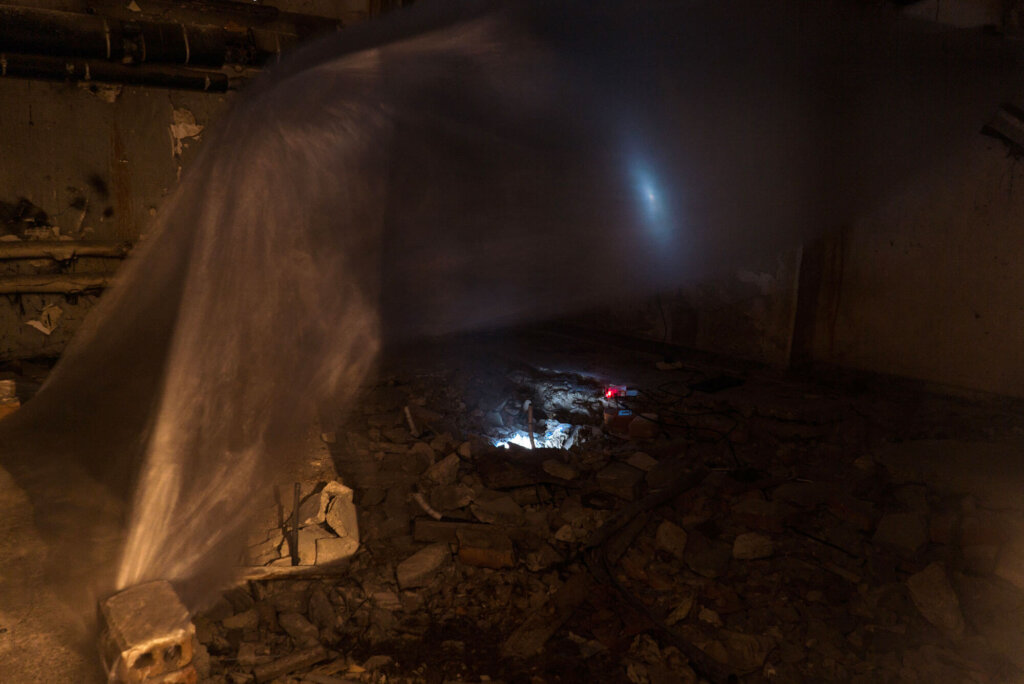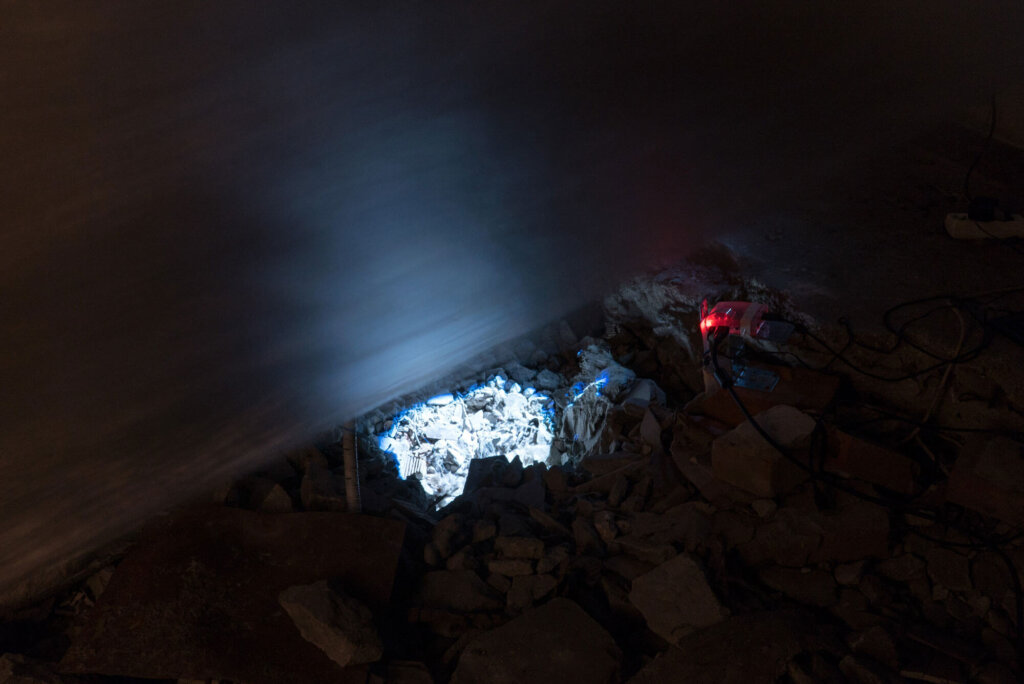”Find”
Silicone Hill, ”Twardowska building” Kraków, Poland, 2017
Interactive and sound installation “Find” was created as part of the 200th anniversary of the Academy of Fine Arts in Krakow and the 5th anniversary of the establishment of the Intermedia Faculty at the Academy of Fine Arts in Krakow. It was also connected with the takeover of a part of the building at ul. Krzemionki 30 in Krakow, where the Krakow branch of public television, TVP, had its headquarters.
The building, built in 1968, underwent various transformations. The part which the Faculty received was initially a restaurant with a network of corridors and technical facilities. Currently, most rooms need renovation or are in a state of renovation lasting for many years. The rest of the building is in constant use by TVP Kraków.
“Find” is a work that is in the context of a place and situation. We live in times where different media create the image of reality. Their reliability and approach to historical facts are determined by people and their knowledge and ethical attitude. My work is an attempt to enter into a dialogue with the way of presenting facts and their interpretation. In the times of the incessant spectacle and the multitude of information, which cause the increase of the entropy – it is difficult to choose the right and impartial message. The amount of information means that viewers often do not want or do not have time to sort and extract those objective and valuable ones. It is easy to manipulate. It seems that the British BBC television is still the model for many stations. It does not change the fact that they often “live” and are repeated information that has no confirmation in facts and credible sources. Hence, the “polyphony” is important so that the society can assess whether the given medium is objective or whether it is a propaganda tube of the station’s owner or any formation deciding about the substantive shape.
Below is description, which was hang on the artificial wall during the show:
/ Genesis
During renovation works in the television building at ul. Twardowska in 2017, the construction team breaking the floor came across a strange find. Initially, the employees did not think that it was some foreign form. It was only when the “find” began to appear in the same place at irregular but apparent intervals that it caused them anxiety. Initially, they thought it was some kind of optical phenomenon, an illusion. However, there was a suspicion that it could be a bomb. For some people, the “object” appearing was associated with the shape of a bomb. The work was immediately stopped and a team of sappers was called in. Due to the difficulty in reaching the facility, the sappers clearly did not specify whether it is a bomb due to the small amount of explosive. As a result of further inspection and research – especially the place around the “find” – and the expansion of the circle of specialists from other fields, it is not yet possible to state clearly from where and how the object was found there. Neither can it be clearly stated whether it is a bomb or not. Hypotheses, suspicions and assumptions concern foreign interviews and date back to 1968, when the construction of the center began. There are also hypotheses about the influence of extraterrestrial factors. The question that bothers everyone concerns what, since 1968, no mention has been made and no “find” has been observed? Unfortunately, we do not know the answers yet…
/ Appearance
The matter of appearance is not obvious. Employees describe the object differently, sappers still different. Scientists also have an ambiguous opinion about the appearance.
The object has a fairly significant impact on the environment. People feel quite uncertain, because it is not known when the object appears and whether it does not register the environment by accident. In turn, all attempts to record or record show quite significant x-rays in the lights and the object shifts beyond the frame. Hundreds of photos have been taken, but all show the same error. So there is a text description and recordings of witnesses.
/ Impact on the environment and attempts to write
The object has a fairly significant impact on the environment. People feel quite uncertain, because it is not known when the object appears and whether it does not register the environment by accident. In turn, all attempts to record or record show quite significant x-rays in the lights and the object shifts beyond the frame. Hundreds of photos have been taken, but all show the same error. So there is a text description and recordings of witnesses
/ What was agreed?
The shape of the object is variable. The structure that causes it is unknown – let’s call the wave appearing and disappearing. It has been assumed that it is translucent and flexible, although in some people it claims that it has non-transparent and hard places. The collected samples of the object indicate that the object may be a remnant of the times of the Second World War. However, some of its fragments are much older than the others. The matter is complicated by the fact of finding new ones too? Therefore, it is not possible to determine the exact date of origin of the object. The C14 radioactive test is still repeated. The chemical composition of the object is also unclear due to the unstable nature of the object and the relatively long time and variety of conditions in which it was located. Military scientists have determined that minimal traces of explosives are present around the structure of the object, and even some have been able to take samples directly from the object. However, there is a lack of accurate data, and the material obtained so far does not fully agree with known comparable samples. The object has minimal thermal radiation. It is detectable by a thermovision camera, as well as X-rays – mainly soft radiation with a wavelength from 0.1 to 10 nm. and gamma radiation present in the X-ray range.
/ DNA
We know from other studies that traces of human DNA have also been found. The study confirmed that the DNA sequence system coincides with the findings of the genetic atlas of human mixture that appeared in Sciene’s scientific letter in 2014. A map of the DNA mix characteristic of this area is available on the internet at:
http://admixturemap.paintmychromosomes.com
original description:
This interactive map summarizes the results described in the paper “A genetic atlas of human admixture history”, Hellenthal et al, Science (2014). This help page gives a brief summary of the content and structure of the page. (We also suggest reading the FAQ and the tutorial accessible under the ‘Historical event’ menu.) To begin, click on a labelled population on the map (or select one from the “Target” drop-down menu at top). You will see displayed details of past admixture events which we infer to have occurred in forming that population.
For simple admixture events (two source populations admixing at a single point in time) or in “mixing coefficients” view, coloured circles or pie charts on the map depict the inferred genetic make-up of the two (blue and orange) admixing sources involved in the event for the selected population. The real admixing sources will not usually have been sampled, but we infer details of their DNA make-up. To do this, the DNA of each of the two source populations is represented in terms of a mixture of segments of DNA shared with sampled “donor” populations displayed on the map, with the area of each circle (or slice of a pie) proportional to the mixing coefficients for that donor.
For complex admixture events (involving admixture between more than two sources, possibly at different times), in “contrasts” view squares depict the differences in inferred genetic make-up between the two sources, with the area of each square proportional to the amount by which the given “donor” population more greatly represents (shares DNA segments with) one source over the other. (These differences tend to be more stably estimated than the mixing coefficients that we present as circles in these more complex cases.)
The box on the right provides more details about the event depicted, including the estimated date of the admixture event, the total estimated proportion of admixture from the first (orange) source, and our conclusion (“no admixture”, “one date”, “one date, multiway”, or “multiple dates”). In the box, “side 1” depicts donor populations involved in the mixture describing the orange source and “side 2” depicts donor populations involved in the mixture describing the blue source. Coancestry curves are shown for all pairs of donor populations whose tick-boxes are selected (unless “no curves” is indicated next to the donor population), with black lines the raw data and green lines the fit under the given date(s) and proportion(s) of admixture.
For some populations, we conducted multiple analyses and/or inferred multiple events in a single analysis. For such populations, our results for each analysis and each event are given, and you can toggle between these results using the drop-down menu under “Analysis”. The analysis selected by default is the “full” analysis that uses all populations as potential donors.
In the “Historical event” drop-down menu, we also provide a tutorial on how to use the site, followed by a selection of historical interpretations of admixture signals we see – many of which are shared among several groups. Each event provides text describing our genetic inference and how it might relate to historically attested events, as well as allowing users to click individually on all groups related to the described signal. (These events are also presented in the Supplementary Information.)
/ The presentation
Due to the sensitivity of the test object, as well as the method of determining whether it is there at the moment – we attempted to cover the object with foil. We want the object to have the opportunity to appear, as well as adequate ventilation and maintaining the appropriate temperature. Thanks to the translucent foil, the object influences the height achieved by the foil during lifting. The amplitude is rather constant, but for a skilled and perceptive viewer, the differences are noticeable.
/ Technically:
foil, arduino uno: microcontroller, motion sensor, 4 air pumps, plastic tubes, LED spotlight with focusing lens, prints, photos, drawings
*The EAO – An Extraordinary Art Object – emerges from the experience and exists not as a result of a single event of rule. The EAO comprises multiple components – but is more than the sum of its parts. The EAO components are to constitute separate pieces of art, but essential are the intermedia correlations between the individual existences that lead to its creation, and its contextual aspects that affect the viewer and, more often than not, rely on his activity.
